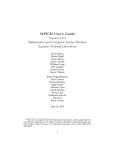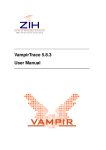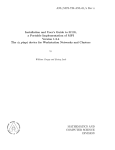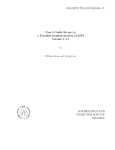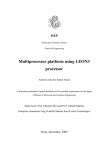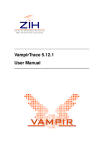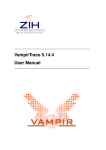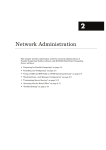Download MPICH2 1.3.1 User Guide
Transcript
MPICH2 User’s Guide∗
Version 1.3.1
Mathematics and Computer Science Division
Argonne National Laboratory
Pavan Balaji
Darius Buntinas
Ralph Butler
Anthony Chan
David Goodell
William Gropp
Jayesh Krishna
Rob Latham
Ewing Lusk
Guillaume Mercier
Rob Ross
Rajeev Thakur
Past Contributors:
David Ashton
Brian Toonen
November 17, 2010
∗
This work was supported by the Mathematical, Information, and Computational Sciences Division subprogram of the Office of Advanced Scientific Computing Research, SciDAC Program, Office of Science, U.S. Department of Energy, under Contract DE-AC0206CH11357.
1
Contents
1 Introduction
1
2 Getting Started with MPICH2
1
2.1
Default Runtime Environment
. . . . . . . . . . . . . . . . .
1
2.2
Starting Parallel Jobs . . . . . . . . . . . . . . . . . . . . . .
1
2.3
Command-Line Arguments in Fortran . . . . . . . . . . . . .
1
3 Quick Start
2
4 Compiling and Linking
3
4.1
Special Issues for C++ . . . . . . . . . . . . . . . . . . . . . .
3
4.2
Special Issues for Fortran . . . . . . . . . . . . . . . . . . . .
3
5 Running Programs with mpiexec
4
5.1
Standard mpiexec . . . . . . . . . . . . . . . . . . . . . . . .
4
5.2
Extensions for All Process Management Environments . . . .
5
5.3
mpiexec Extensions for the Hydra Process Manager . . . . .
5
5.4
mpiexec Extensions for the MPD Process Manager . . . . . .
5
5.4.1
Basic mpiexec arguments for MPD . . . . . . . . . . .
5
5.4.2
Other Command-Line Arguments to mpiexec for MPD
6
5.4.3
Environment Variables Affecting mpiexec for MPD . .
10
Extensions for SMPD Process Management Environment . .
10
5.5.1
mpiexec arguments for SMPD . . . . . . . . . . . . .
11
Extensions for the gforker Process Management Environment
13
5.6.1
14
5.5
5.6
5.7
mpiexec arguments for gforker . . . . . . . . . . . . .
Restrictions of the remshell Process Management Environment 15
i
5.8
Using MPICH2 with SLURM and PBS . . . . . . . . . . . . .
16
5.8.1
MPD in the PBS environment . . . . . . . . . . . . .
16
5.8.2
OSC mpiexec . . . . . . . . . . . . . . . . . . . . . . .
17
6 Managing the Process Management Environment
6.1
MPD . . . . . . . . . . . . . . . . . . . . . . . . . . . . . . . .
7 Debugging
17
17
18
7.1
gdb via mpiexec . . . . . . . . . . . . . . . . . . . . . . . . .
18
7.2
TotalView . . . . . . . . . . . . . . . . . . . . . . . . . . . . .
22
8 Checkpointing
23
8.1
Configuring for checkpointing . . . . . . . . . . . . . . . . . .
23
8.2
Taking checkpoints . . . . . . . . . . . . . . . . . . . . . . . .
24
9 MPE
25
9.1
MPI Logging . . . . . . . . . . . . . . . . . . . . . . . . . . .
25
9.2
User-defined logging . . . . . . . . . . . . . . . . . . . . . . .
25
9.3
MPI Checking . . . . . . . . . . . . . . . . . . . . . . . . . . .
27
9.4
MPE options . . . . . . . . . . . . . . . . . . . . . . . . . . .
27
10 Other Tools Provided with MPICH2
28
11 MPICH2 under Windows
28
11.1 Directories . . . . . . . . . . . . . . . . . . . . . . . . . . . . .
28
11.2 Compiling . . . . . . . . . . . . . . . . . . . . . . . . . . . . .
29
11.3 Running . . . . . . . . . . . . . . . . . . . . . . . . . . . . . .
29
A Frequently Asked Questions
30
ii
1 INTRODUCTION
1
1
Introduction
This manual assumes that MPICH2 has already been installed. For instructions on how to install MPICH2, see the MPICH2 Installer’s Guide, or the
README in the top-level MPICH2 directory. This manual explains how to
compile, link, and run MPI applications, and use certain tools that come
with MPICH2. This is a preliminary version and some sections are not
complete yet. However, there should be enough here to get you started with
MPICH2.
2
Getting Started with MPICH2
MPICH2 is a high-performance and widely portable implementation of the
MPI Standard, designed to implement all of MPI-1 and MPI-2 (including
dynamic process management, one-sided operations, parallel I/O, and other
extensions). The MPICH2 Installer’s Guide provides some information on
MPICH2 with respect to configuring and installing it. Details on compiling,
linking, and running MPI programs are described below.
2.1
Default Runtime Environment
MPICH2 provides a separation of process management and communication.
The default runtime environment in MPICH2 is called Hydra. Other process
managers are also available.
2.2
Starting Parallel Jobs
MPICH2 implements mpiexec and all of its standard arguments, together
with some extensions. See Section 5.1 for standard arguments to mpiexec
and various subsections of Section 5 for extensions particular to various
process management systems.
2.3
Command-Line Arguments in Fortran
MPICH1 (more precisely MPICH1’s mpirun) required access to command
line arguments in all application programs, including Fortran ones, and
3 QUICK START
2
MPICH1’s configure devoted some effort to finding the libraries that contained the right versions of iargc and getarg and including those libraries
with which the mpif77 script linked MPI programs. Since MPICH2 does not
require access to command line arguments to applications, these functions
are optional, and configure does nothing special with them. If you need
them in your applications, you will have to ensure that they are available in
the Fortran environment you are using.
3
Quick Start
To use MPICH2, you will have to know the directory where MPICH2 has
been installed. (Either you installed it there yourself, or your systems administrator has installed it. One place to look in this case might be /usr/local.
If MPICH2 has not yet been installed, see the MPICH2 Installer’s Guide.)
We suggest that you put the bin subdirectory of that directory into your
path. This will give you access to assorted MPICH2 commands to compile,
link, and run your programs conveniently. Other commands in this directory
manage parts of the run-time environment and execute tools.
One of the first commands you might run is mpich2version to find out
the exact version and configuration of MPICH2 you are working with. Some
of the material in this manual depends on just what version of MPICH2 you
are using and how it was configured at installation time.
You should now be able to run an MPI program. Let us assume that the
directory where MPICH2 has been installed is /home/you/mpich2-installed,
and that you have added that directory to your path, using
setenv PATH /home/you/mpich2-installed/bin:$PATH
for tcsh and csh, or
export PATH=/home/you/mpich2-installed/bin:$PATH
for bash or sh. Then to run an MPI program, albeit only on one machine,
you can do:
cd /home/you/mpich2-installed/examples
mpiexec -n 3 ./cpi
4 COMPILING AND LINKING
3
Details for these commands are provided below, but if you can successfully execute them here, then you have a correctly installed MPICH2 and
have run an MPI program.
4
Compiling and Linking
A convenient way to compile and link your program is by using scripts that
use the same compiler that MPICH2 was built with. These are mpicc,
mpicxx, mpif77, and mpif90, for C, C++, Fortran 77, and Fortran 90 programs, respectively. If any of these commands are missing, it means that
MPICH2 was configured without support for that particular language.
4.1
Special Issues for C++
Some users may get error messages such as
SEEK_SET is #defined but must not be for the C++ binding of MPI
The problem is that both stdio.h and the MPI C++ interface use SEEK SET,
SEEK CUR, and SEEK END. This is really a bug in the MPI-2 standard. You
can try adding
#undef SEEK_SET
#undef SEEK_END
#undef SEEK_CUR
before mpi.h is included, or add the definition
-DMPICH_IGNORE_CXX_SEEK
to the command line (this will cause the MPI versions of SEEK SET etc. to
be skipped).
4.2
Special Issues for Fortran
MPICH2 provides two kinds of support for Fortran programs. For Fortran 77
programmers, the file mpif.h provides the definitions of the MPI constants
5 RUNNING PROGRAMS WITH MPIEXEC
4
such as MPI COMM WORLD. Fortran 90 programmers should use the MPI module
instead; this provides all of the definitions as well as interface definitions for
many of the MPI functions. However, this MPI module does not provide
full Fortran 90 support; in particular, interfaces for the routines, such as
MPI Send, that take “choice” arguments are not provided.
5
Running Programs with mpiexec
The MPI-2 Standard describes mpiexec as a suggested way to run MPI
programs. MPICH2 implements the mpiexec standard, and also provides
some extensions.
5.1
Standard mpiexec
Here we describe the standard mpiexec arguments from the MPI-2 Standard [1]. The simplest form of a command to start an MPI job is
mpiexec -f machinefile -n 32 a.out
to start the executable a.out with 32 processes (providing an MPI COMM WORLD
of size 32 inside the MPI application). Other options are supported, for
search paths for executables, working directories, and even a more general
way of specifying a number of processes. Multiple sets of processes can be
run with different executables and different values for their arguments, with
“:” separating the sets of processes, as in:
mpiexec -f machinefile -n 1 ./master : -n 32 ./slave
It is also possible to start a one process MPI job (with a MPI COMM WORLD
whose size is equal to 1), without using mpiexec. This process will become
an MPI process when it calls MPI Init, and it may then call other MPI
functions. Currently, MPICH2 does not fully support calling the dynamic
process routines from MPI-2 (e.g., MPI Comm spawn or MPI Comm accept)
from processes that are not started with mpiexec.
5 RUNNING PROGRAMS WITH MPIEXEC
5.2
5
Extensions for All Process Management Environments
Some mpiexec arguments are specific to particular communication subsystems (“devices”) or process management environments (“process managers”). Our intention is to make all arguments as uniform as possible
across devices and process managers. For the time being we will document
these separately.
5.3
mpiexec Extensions for the Hydra Process Manager
MPICH2 provides a number of process management systems. Hydra is the
default process manager in MPICH2. More details on Hydra and its extensions to mpiexec can be found at http://wiki.mcs.anl.gov/mpich2/
index.php/Using_the_Hydra_Process_Manager
5.4
mpiexec Extensions for the MPD Process Manager
5.4.1
Basic mpiexec arguments for MPD
Before running MPD’s mpiexec, the runtime environment must be established. In the case of MPD, the daemons must be running. See Section 6.1
for how to run and manage the MPD daemons.
We assume that the MPD ring is up and the installation’s bin directory
is in your path; that is, you can do:
mpdtrace
and it will output a list of nodes on which you can run MPI programs. Now
you are ready to run a program with mpiexec. Let us assume that you
have compiled and linked the program cpi (in the installdir/examples
directory and that this directory is in your PATH. Or that is your current
working directory and ‘.’ (“dot”) is in your PATH. The simplest thing to
do is
mpiexec -n 5 cpi
to run cpi on five nodes. The process management system (such as MPD)
5 RUNNING PROGRAMS WITH MPIEXEC
6
will choose machines to run them on, and cpi will tell you where each is
running.
You can use mpiexec to run non-MPI programs as well. This is sometimes useful in making sure all the machines are up and ready for use. Useful
examples include
mpiexec -n 10 hostname
and
mpiexec -n 10 printenv
5.4.2
Other Command-Line Arguments to mpiexec for MPD
The MPI-2 standard specifies the syntax and semantics of the arguments -n,
-path,-wdir, -host, -file, -configfile, and -soft. All of these are currently implemented for MPD’s mpiexec. Each of these is what we call a “local” option, since its scope is the processes in the set of processes described
between colons, or on separate lines of the file specified by -configfile. We
add some extensions that are local in this way and some that are “global” in
the sense that they apply to all the processes being started by the invocation
of mpiexec.
The MPI-2 Standard provides a way to pass different arguments to different application processes, but does not provide a way to pass environment
variables. MPICH2 provides an extension that supports environment variables. The local parameter -env does this for one set of processes. That
is,
mpiexec -n 1 -env FOO BAR a.out : -n 2 -env BAZZ FAZZ b.out
makes BAR the value of environment variable FOO on the first process, running
the executable a.out, and gives the environment variable BAZZ the value
FAZZ on the second two processes, running the executable b.out. To set an
environment variable without giving it a value, use ’’ as the value in the
above command line.
The global parameter -genv can be used to pass the same environment
variables to all processes. That is,
5 RUNNING PROGRAMS WITH MPIEXEC
7
mpiexec -genv FOO BAR -n 2 a.out : -n 4 b.out
makes BAR the value of the environment variable FOO on all six processes. If
-genv appears, it must appear in the first group. If both -genv and -env
are used, the -env’s add to the environment specified or added to by the
-genv variables. If there is only one set of processes (no “:”), the -genv
and -env are equivalent.
The local parameter -envall is an abbreviation for passing the entire environment in which mpiexec is executed. The global version of it
is -genvall. This global version is implicitly present. To pass no environment variables, use -envnone and -genvnone. So, for example, to set
only the environment variable FOO and no others, regardless of the current
environment, you would use
mpiexec -genvnone -env FOO BAR -n 50 a.out
In the case of MPD, we currently make an exception for the PATH environment variable, which is always passed through. This exception was added
to make it unnecessary to explicitly pass this variable in the default case.
A list of environment variable names whose values are to be copied
from the current environment can be given with the -envlist (respectively,
-genvlist) parameter; for example,
mpiexec -genvnone -envlist HOME,LD_LIBRARY_PATH -n 50 a.out
sets the HOME and LD LIBRARY PATH in the environment of the a.out processes to their values in the environment where mpiexec is being run. In
this situation you can’t have commas in the environment variable names,
although of course they are permitted in values.
Some extension parameters have only global versions. They are
-l provides rank labels for lines of stdout and stderr. These are a bit
obscure for processes that have been explicitly spawned, but are still
useful.
-usize sets the “universe size” that is retrieved by the MPI attribute
MPI UNIVERSE SIZE on MPI COMM WORLD.
5 RUNNING PROGRAMS WITH MPIEXEC
8
-bnr is used when one wants to run executables that have been compiled
and linked using the ch p4mpd or myrinet device in MPICH1. The
MPD process manager provides backward compatibility in this case.
-machinefile can be used to specify information about each of a set of
machines. This information may include the number of processes to
run on each host when executing user programs. For example, assume
that a machinefile named mf contains:
# comment line
hosta
hostb:2
hostc
ifhn=hostc-gige
hostd:4 ifhn=hostd-gige
In addition to specifying hosts and number of processes to run on
each, this machinefile indicates that processes running on hostc and
hostd should use the gige interface on hostc and hostd respectively
for MPI communications. (ifhn stands for “interface host name” and
should be set to an alternate host name for the machine that is used
to designate an alternate communication interface.) This interface
information causes the MPI implementation to choose the alternate
host name when making connections. When the alternate hostname
specifies a particular interface, MPICH communication will then travel
over that interface.
You might use this machinefile in the following way:
mpiexec -machinefile mf -n 7 p0
Process rank 0 is to run on hosta, ranks 1 and 2 on hostb, rank 3 on
hostc, and ranks 4-6 on hostd. Note that the file specifies information
for up to 8 ranks and we only used 7. That is OK. But, if we had used
“-n 9”, an error would be raised. The file is not used as a pool of
machines that are cycled through; the processes are mapped to the
hosts in the order specified in the file.
A more complex command-line example might be:
mpiexec -l -machinefile mf -n 3 p1 : -n 2 p2 : -n 2 p3
5 RUNNING PROGRAMS WITH MPIEXEC
9
Here, ranks 0-2 all run program p1 and are executed placing rank 0
on hosta and ranks 1-2 on hostb. Similarly, ranks 3-4 run p2 and are
executed on hostc and hostd, respectively. Ranks 5-6 run on hostd
and execute p3.
-s can be used to direct the stdin of mpiexec to specific processes in a
parallel job. For example:
mpiexec -s all -n 5 a.out
directs the stdin of mpiexec to all five processes.
mpiexec -s 4 -n 5 a.out
directs it to just the process with rank 4, and
mpiexec -s 1,3 -n 5 a.out
sends it to processes 1 and 3, while
mpiexec -s 0-3 -n 5 a.out
sends stdin to processes 0, 1, 2, and 3.
The default, if -s is not specified, is to send mpiexec’s stdin to process
0 only.
The redirection of -stdin through mpiexec to various MPI processes
is intended primarily for interactive use. Because of the complexity
of buffering large amounts of data at various processes that may not
have read it yet, the redirection of large amounts of data to mpiexec’s
stdin is discouraged, and may cause unexpected results. That is,
mpiexec -s all -n 5 a.out < bigfile
should not be used if bigfile is more than a few lines long. Have
one of the processes open the file and read it instead. The functions
in MPI-IO may be useful for this purpose.
A “:” can optionally be used between global args and normal argument
sets, e.g.:
5 RUNNING PROGRAMS WITH MPIEXEC
10
mpiexec -l -n 1 -host host1 pgm1 : -n 4 -host host2 pgm2
is equivalent to:
mpiexec -l : -n 1 -host host1 pgm1 : -n 4 -host host2 pgm2
This option implies that the global arguments can occur on a separate line in
the file specified by -configfile when it is used to replace a long command
line.
5.4.3
Environment Variables Affecting mpiexec for MPD
A small number of environment variables affect the behavior of mpiexec.
MPIEXEC TIMEOUT The value of this environment variable is the maximum
number of seconds this job will be permitted to run. When time is up,
the job is aborted.
MPIEXEC PORT RANGE If this environment variable is defined then the MPD
system will restrict its usage of ports for connecting its various processes to ports in this range. If this variable is not assigned, but
MPICH PORT RANGE is assigned, then it will use the range specified by
MPICH PORT RANGE for its ports. Otherwise, it will use whatever ports
are assigned to it by the system. Port ranges are given as a pair of
integers separated by a colon.
MPIEXEC BNR If this environment variable is defined (its value, if any, is
currently insignificant), then MPD will act in backward-compatibility
mode, supporting the BNR interface from the original MPICH (e.g.
versions 1.2.0 – 1.2.7p1) instead of its native PMI interface, as a way for
application processes to interact with the process management system.
MPD CON EXT Adds a string to the default Unix socket name used by mpiexec
to find the local mpd. This allows one to run multiple mpd rings at
the same time.
5.5
Extensions for SMPD Process Management Environment
SMPD is an alternate process manager that runs on both Unix and Windows. It can launch jobs across both platforms if the binary formats match
5 RUNNING PROGRAMS WITH MPIEXEC
11
(big/little endianness and size of C types– int, long, void*, etc).
5.5.1
mpiexec arguments for SMPD
mpiexec for smpd accepts the standard MPI-2 mpiexec options. Execute
mpiexec
or
mpiexec -help2
to print the usage options. Typical usage:
mpiexec -n 10 myapp.exe
All options to mpiexec:
-n x
-np x
launch x processes
-localonly x
-np x -localonly
launch x processes on the local machine
-machinefile filename
use a file to list the names of machines to launch on
-host hostname
launch on the specified host.
-hosts n host1 host2 ...
hostn
-hosts n host1 m1 host2 m2 ... hostn mn
launch on the specified hosts. In the second version the number of
processes = m1 + m2 + ... + mn
-dir drive:\my\working\directory
5 RUNNING PROGRAMS WITH MPIEXEC
12
-wdir /my/working/directory
launch processes with the specified working directory. (-dir and -wdir
are equivalent)
-env var val
set environment variable before launching the processes
-exitcodes
print the process exit codes when each process exits.
-noprompt
prevent mpiexec from prompting for user credentials. Instead errors
will be printed and mpiexec will exit.
-localroot
launch the root process directly from mpiexec if the host is local. (This
allows the root process to create windows and be debugged.)
-port port
-p port
specify the port that smpd is listening on.
-phrase passphrase
specify the passphrase to authenticate connections to smpd with.
-smpdfile filename
specify the file where the smpd options are stored including the passphrase.
(unix only option)
-path search path
search path for executable, ; separated
-timeout seconds
timeout for the job.
Windows specific options:
-map drive:\\host\share
map a drive on all the nodes this mapping will be removed when the
processes exit
-logon
prompt for user account and password
5 RUNNING PROGRAMS WITH MPIEXEC
13
-pwdfile filename
read the account and password from the file specified.
put the account on the first line and the password on the second
-nopopup debug
disable the system popup dialog if the process crashes
-priority class[:level]
set the process startup priority class and optionally level.
class = 0,1,2,3,4 = idle, below, normal, above, high
level = 0,1,2,3,4,5 = idle, lowest, below, normal, above, highest
the default is -priority 2:3
-register
encrypt a user name and password to the Windows registry.
-remove
delete the encrypted credentials from the Windows registry.
-validate [-host hostname]
validate the encrypted credentials for the current or specified host.
-delegate
use passwordless delegation to launch processes.
-impersonate
use passwordless authentication to launch processes.
-plaintext
don’t encrypt the data on the wire.
5.6
Extensions for the gforker Process Management Environment
gforker is a process management system for starting processes on a single machine, so called because the MPI processes are simply forked from
the mpiexec process. This process manager supports programs that use
MPI Comm spawn and the other dynamic process routines, but does not support the use of the dynamic process routines from programs that are not
started with mpiexec. The gforker process manager is primarily intended
as a debugging aid as it simplifies development and testing of MPI programs
on a single node or processor.
5 RUNNING PROGRAMS WITH MPIEXEC
5.6.1
14
mpiexec arguments for gforker
In addition to the standard mpiexec command-line arguments, the gforker
mpiexec supports the following options:
-np <num> A synonym for the standard -n argument
-env <name> <value> Set the environment variable <name> to <value> for
the processes being run by mpiexec.
-envnone Pass no environment variables (other than ones specified with
other -env or -genv arguments) to the processes being run by mpiexec.
By default, all environment variables are provided to each MPI process
(rationale: principle of least surprise for the user)
-envlist <list> Pass the listed environment variables (names separated
by commas), with their current values, to the processes being run by
mpiexec.
-genv <name> <value> The
-genv options have the same meaning as their corresponding -env version,
except they apply to all executables, not just the current executable (in
the case that the colon syntax is used to specify multiple execuables).
-genvnone Like -envnone, but for all executables
-genvlist <list> Like -envlist, but for all executables
-usize <n> Specify the value returned for the value of the attribute MPI UNIVERSE SIZE.
-l Label standard out and standard error (stdout and stderr) with the
rank of the process
-maxtime <n> Set a timelimit of <n> seconds.
-exitinfo Provide more information on the reason each process exited if
there is an abnormal exit
In addition to the commandline argments, the gforker mpiexec provides
a number of environment variables that can be used to control the behavior
of mpiexec:
5 RUNNING PROGRAMS WITH MPIEXEC
15
MPIEXEC TIMEOUT Maximum running time in seconds. mpiexec will terminate MPI programs that take longer than the value specified by
MPIEXEC TIMEOUT.
MPIEXEC UNIVERSE SIZE Set the universe size
MPIEXEC PORT RANGE Set the range of ports that mpiexec will use in communicating with the processes that it starts. The format of this is
<low>:<high>. For example, to specify any port between 10000 and
10100, use 10000:10100.
MPICH PORT RANGE Has the same meaning as MPIEXEC PORT RANGE and is
used if MPIEXEC PORT RANGE is not set.
MPIEXEC PREFIX DEFAULT If this environment variable is set, output to standard output is prefixed by the rank in MPI COMM WORLD of the process
and output to standard error is prefixed by the rank and the text
(err); both are followed by an angle bracket (>). If this variable is
not set, there is no prefix.
MPIEXEC PREFIX STDOUT Set the prefix used for lines sent to standard output. A %d is replaced with the rank in MPI COMM WORLD; a %w is replaced with an indication of which MPI COMM WORLD in MPI jobs that
involve multiple MPI COMM WORLDs (e.g., ones that use MPI Comm spawn
or MPI Comm connect).
MPIEXEC PREFIX STDERR Like MPIEXEC PREFIX STDOUT, but for standard error.
MPIEXEC STDOUTBUF Sets the buffering mode for standard output. Valid
values are NONE (no buffering), LINE (buffering by lines), and BLOCK
(buffering by blocks of characters; the size of the block is implementation defined). The default is NONE.
MPIEXEC STDERRBUF Like MPIEXEC STDOUTBUF, but for standard error.
5.7
Restrictions of the remshell Process Management Environment
The remshell “process manager” provides a very simple version of mpiexec
that makes use of the secure shell command (ssh) to start processes on a
collection of machines. As this is intended primarily as an illustration of
5 RUNNING PROGRAMS WITH MPIEXEC
16
how to build a version of mpiexec that works with other process managers,
it does not implement all of the features of the other mpiexec programs
described in this document. In particular, it ignores the command line
options that control the environment variables given to the MPI programs.
It does support the same output labeling features provided by the gforker
version of mpiexec. However, this version of mpiexec can be used much like
the mpirun for the ch p4 device in MPICH-1 to run programs on a collection
of machines that allow remote shells. A file by the name of machines should
contain the names of machines on which processes can be run, one machine
name per line. There must be enough machines listed to satisfy the requested
number of processes; you can list the same machine name multiple times if
necessary.
For more complex needs or for faster startup, we recommend the use of
the mpd process manager.
5.8
Using MPICH2 with SLURM and PBS
There are multiple ways of using MPICH2 with SLURM or PBS. Hydra
provides native support for both SLURM and PBS, and is likely the easiest
way to use MPICH2 on these systems (see the Hydra documentation above
for more details).
Alternatively, SLURM also provides compatibility with MPICH2’s internal process management interface. To use this, you need to configure
MPICH2 with SLURM support, and then use the srun job launching utility
provided by SLURM.
For PBS, MPICH2 jobs can be launched in three ways: (i) use Hydra’s
mpiexec with the appropriate options corresponding to PBS, (ii) using MPD
or (iii) using the OSC mpiexec.
5.8.1
MPD in the PBS environment
PBS specifies the machines allocated to a particular job in the file $PBS NODEFILE.
But the format used by PBS is different from that of MPD. Specifically, PBS
lists each node on a single line; if a node (n0) has two processors, it is listed
twice. MPD on the other hand uses an identifier (ncpus) to describe how
many processors a node has. So, if n0 has two processors, it is listed as n0:2.
6 MANAGING THE PROCESS MANAGEMENT ENVIRONMENT 17
One way to convert the node file to the MPD format is as follows:
sort $PBS NODEFILE | uniq -C | awk ’{ printf(”%s:%s”, $2, $1); }’ >
mpd.nodes
Once the PBS node file is converted, MPD can be normally started
within the PBS job script using mpdboot and torn down using mpdallexit.
mpdboot -f mpd.hosts -n [NUM NODES REQUESTED]
mpiexec -n [NUM PROCESSES] ./my test program
mpdallexit
5.8.2
OSC mpiexec
Pete Wyckoff from the Ohio Supercomputer Center provides a alternate
utility called OSC mpiexec to launch MPICH2 jobs on PBS systems without
using MPD. More information about this can be found here: http://www.
osc.edu/~pw/mpiexec
6
Managing the Process Management Environment
Some of the process managers supply user commands that can be used to
interact with the process manager and to control jobs. In this section we
describe user commands that may be useful.
6.1
MPD
mpd starts an mpd daemon.
mpdboot starts a set of mpd’s on a list of machines.
mpdtrace lists all the MPD daemons that are running. The -l option lists
full hostnames and the port where the mpd is listening.
mpdlistjobs lists the jobs that the mpd’s are running. Jobs are identified
by the name of the mpd where they were submitted and a number.
mpdkilljob kills a job specified by the name returned by mpdlistjobs
7 DEBUGGING
18
mpdsigjob delivers a signal to the named job. Signals are specified by name
or number.
You can use keystrokes to provide signals in the usual way, where mpiexec
stands in for the entire parallel application. That is, if mpiexec is being
run in a Unix shell in the foreground, you can use ^C (control-C) to send
a SIGINT to the processes, or ^Z (control-Z) to suspend all of them. A
suspended job can be continued in the usual way.
Precise argument formats can be obtained by passing any MPD command the --help or -h argument. More details can be found in the README
in the mpich2 top-level directory or the README file in the MPD directory
mpich2/src/pm/mpd.
7
Debugging
Debugging parallel programs is notoriously difficult. Here we describe a
number of approaches, some of which depend on the exact version of MPICH2
you are using.
7.1
gdb via mpiexec
If you are using the MPD process manager, you can use the -gdb argument to
mpiexec to execute a program with each process running under the control
of the gdb sequential debugger. The -gdb option helps control the multiple
instances of gdb by sending stdin either to all processes or to a selected
process and by labeling and merging output. The current implementation
has some minor limitations. For example, we do not support setting your
own prompt. This is because we capture the gdb output and examine it
before processing it, e.g. merging identical lines. Also, we set a breakpoint
at the beginning of main to get all processes synchronized at the beginning.
Thus, the user will have a duplicate, unusable breakpoint if he sets one at
the very first executable line of main. Otherwise, to the extent possible,
we try to simply pass user input through to gdb and lets things progress
normally.
The following script of a -gdb session gives an idea of how this works.
Input keystrokes are sent to all processes unless specifially directed by the
7 DEBUGGING
19
“z” command.
ksl2%
0-9:
0-9:
0-9:
0-9:
0-9:
0-9:
0-9:
0-9:
0-9:
0-9:
0-9:
0-9:
0-9:
0-9:
0-9:
0-9:
0-9:
0-9:
0-9:
0-9:
0-9:
0-9:
0-9:
0-9:
0-9:
0-9:
0-9:
0-9:
0-9:
0-9:
0-9:
0-9:
0-9:
0-9:
0-9:
mpiexec -gdb -n 10 cpi
(gdb) l
5 double f(double);
6
7 double f(double a)
8 {
9
return (4.0 / (1.0 + a*a));
10
}
11
12
int main(int argc,char *argv[])
13
{
14
int done = 0, n, myid, numprocs, i;
(gdb)
15
double PI25DT = 3.141592653589793238462643;
16
double mypi, pi, h, sum, x;
17
double startwtime = 0.0, endwtime;
18
int namelen;
19
char processor_name[MPI_MAX_PROCESSOR_NAME];
20
21
MPI_Init(&argc,&argv);
22
MPI_Comm_size(MPI_COMM_WORLD,&numprocs);
23
MPI_Comm_rank(MPI_COMM_WORLD,&myid);
24
MPI_Get_processor_name(processor_name,&namelen);
(gdb)
25
26
fprintf(stdout,"Process %d of %d is on %s\n",
27
myid, numprocs, processor_name);
28
fflush(stdout);
29
30
n = 10000;
/* default # of rectangles */
31
if (myid == 0)
32
startwtime = MPI_Wtime();
33
34
MPI_Bcast(&n, 1, MPI_INT, 0, MPI_COMM_WORLD);
(gdb) b 30
Breakpoint 2 at 0x4000000000002541:
file /home/lusk/mpich2/examples/cpi.c, line 30.
0-9: (gdb) r
0-9: Continuing.
0: Process 0 of 10 is on ksl2
1: Process 1 of 10 is on ksl2
2: Process 2 of 10 is on ksl2
3: Process 3 of 10 is on ksl2
7 DEBUGGING
4: Process 4 of 10 is on ksl2
5: Process 5 of 10 is on ksl2
6: Process 6 of 10 is on ksl2
7: Process 7 of 10 is on ksl2
8: Process 8 of 10 is on ksl2
9: Process 9 of 10 is on ksl2
0-9:
0-9: Breakpoint 2, main (argc=1, argv=0x60000fffffffb4b8)
0-9:
at /home/lusk/mpich2/examples/cpi.c:30
0-9: 30
n = 10000;
* default # of rectangles */
0-9: (gdb) n
0-9: 31
if (myid == 0)
0-9: (gdb) n
0: 32
startwtime = MPI_Wtime();
1-9: 34
MPI_Bcast(&n, 1, MPI_INT, 0, MPI_COMM_WORLD);
0-9: (gdb) z 0
0: (gdb) n
0: 34
MPI_Bcast(&n, 1, MPI_INT, 0, MPI_COMM_WORLD);
0: (gdb) z
0-9: (gdb) where
0-9: #0 main (argc=1, argv=0x60000fffffffb4b8)
0-9:
at /home/lusk/mpich2/examples/cpi.c:34
0-9: (gdb) n
0-9: 36
h
= 1.0 / (double) n;
0-9: (gdb)
0-9: 37
sum = 0.0;
0-9: (gdb)
0-9: 39
for (i = myid + 1; i <= n; i += numprocs)
0-9: (gdb)
0-9: 41
x = h * ((double)i - 0.5);
0-9: (gdb)
0-9: 42
sum += f(x);
0-9: (gdb)
0-9: 39
for (i = myid + 1; i <= n; i += numprocs)
0-9: (gdb)
0-9: 41
x = h * ((double)i - 0.5);
0-9: (gdb)
0-9: 42
sum += f(x);
0-9: (gdb)
0-9: 39
for (i = myid + 1; i <= n; i += numprocs)
0-9: (gdb)
0-9: 41
x = h * ((double)i - 0.5);
0-9: (gdb)
0-9: 42
sum += f(x);
0-9: (gdb)
20
7 DEBUGGING
21
0-9: 39
for (i = myid + 1; i <= n; i += numprocs)
0-9: (gdb)
0-9: 41
x = h * ((double)i - 0.5);
0-9: (gdb)
0-9: 42
sum += f(x);
0-9: (gdb)
0-9: 39
for (i = myid + 1; i <= n; i += numprocs)
0-9: (gdb)
0-9: 41
x = h * ((double)i - 0.5);
0-9: (gdb)
0-9: 42
sum += f(x);
0-9: (gdb)
0-9: 39
for (i = myid + 1; i <= n; i += numprocs)
0-9: (gdb)
0-9: 41
x = h * ((double)i - 0.5);
0-9: (gdb)
0-9: 42
sum += f(x);
0-9: (gdb) p sum
0: $1 = 19.999875951497799
1: $1 = 19.999867551672725
2: $1 = 19.999858751863549
3: $1 = 19.999849552071328
4: $1 = 19.999839952297158
5: $1 = 19.999829952542203
6: $1 = 19.999819552807658
7: $1 = 19.999808753094769
8: $1 = 19.999797553404832
9: $1 = 19.999785953739192
0-9: (gdb) c
0-9: Continuing.
0: pi is approximately 3.1415926544231256, Error is 0.0000000008333325
1-9:
1-9: Program exited normally.
1-9: (gdb) 0: wall clock time = 44.909412
0:
0: Program exited normally.
0: (gdb) q
0-9: MPIGDB ENDING
ksl2%
You can attach to a running job with
mpiexec -gdba <jobid>
7 DEBUGGING
22
where <jobid> comes from mpdlistjobs.
7.2
TotalView
MPICH2 supports use of the TotalView debugger from Etnus, through the
MPD process manager only. If MPICH2 has been configured to enable
debugging with TotalView (See the section on configuration of the MPD
process manager in the Installer’s Guide) then one can debug an MPI program started with MPD by adding -tv to the global mpiexec arguments,
as in
mpiexec -tv -n 3 cpi
You will get a popup window from TotalView asking whether you want to
start the job in a stopped state. If so, when the TotalView window appears,
you may see assembly code in the source window. Click on main in the stack
window (upper left) to see the source of the main function. TotalView will
show that the program (all processes) are stopped in the call to MPI Init.
When debugging with TotalView using the above startup sequence, MPICH2
jobs cannot be restarted without exiting TotalView. In MPICH2 version
1.0.6 or later, TotalView can be invoked on an MPICH2 job as follows:
totalview python -a ‘which mpiexec‘ -tvsu \
<mpiexec args> <program> <program args>
and the MPICH2 job will be fully restartable within TotalView.
If you have MPICH2 version 1.0.6 or later and TotalView 8.1.0 or later,
you can use a TotalView feature called indirect launch with MPICH2. Invoke
TotalView as:
totalview <program> -a <program args>
Then select the Process/Startup Parameters command. Choose the Parallel
tab in the resulting dialog box and choose MPICH2 as the parallel system.
Then set the number of tasks using the Tasks field and enter other needed
mpiexec arguments into the Additional Starter Arguments field.
8 CHECKPOINTING
23
If you want to be able to attach to a running MPICH2 job using TotalView, you must use the -tvsu option to mpiexec when starting the job.
Using this option will add a barrier inside MPI Init and hence may affect
startup performance slightly. It will have no effect on the running of the
job once all tasks have returned from MPI Init. In order to debug a running MPICH2 job, you must attach TotalView to the instance of Python
that is running the mpiexec script. If you have just one task running on
the node where you invoked mpiexec, and no other Python scripts running,
there will be three instances of Python running on the node. One of these
is the parent of the MPICH2 task on that node, and one is the parent of
that Python process. Neither of those is the instance of Python you want
to attach to—they are both running the MPD script. The third instance of
Python has no children and is not the child of a Python process. That is
the one that is running mpiexec and is the one you want to attach to.
8
Checkpointing
MPICH2 supports checkpoint/rollback fault tolerance when used with the
Hydra process manager. Currently only the BLCR checkpointing library is
supported. BLCR needs to be installed separately. Below we describe how
to enable the feature in MPICH2 and how to use it. This information can
also be found on the MPICH Wiki: http://wiki.mcs.anl.gov/mpich2/
index.php/Checkpointing
8.1
Configuring for checkpointing
First, you need to have BLCR version 0.8.2 installed on your machine. If
it’s installed in the default system location, add the following two options
to your configure command:
--enable-checkpointing --with-hydra-ckpointlib=blcr
If BLCR is not installed in the default system location, you’ll need to
tell MPICH2’s configure where to find it. You might also need to set the
LD LIBRARY PATH environment variable so that BLCR’s shared libraries can
be found. In this case add the following options to your configure command:
--enable-checkpointing --with-hydra-ckpointlib=blcr
--with-blcr=BLCR_INSTALL_DIR LD_LIBRARY_PATH=BLCR_INSTALL_DIR/lib
8 CHECKPOINTING
24
where BLCR INSTALL DIR is the directory where BLCR has been installed
(whatever was specified in --prefix when BLCR was configured). Note,
checkpointing is only supported with the Hydra process manager. Hyrda
will used by default, unless you choose something else with the --with-pm=
configure option.
After it’s configured, compile as usual (e.g., make; make install).
8.2
Taking checkpoints
To use checkpointing, include the -ckpointlib option for mpiexec to specify the checkpointing library to use and -ckpoint-prefix to specify the
directory where the checkpoint images should be written:
shell$ mpiexec -ckpointlib blcr \
-ckpoint-prefix /home/buntinas/ckpts/app.ckpoint \
-f hosts -n 4 ./app
While the application is running, the user can request for a checkpoint at
any time by sending a SIGUSR1 signal to mpiexec. You can also automatically checkpoint the application at regular intervals using the mpiexec option
-ckpoint-interval to specify the number of seconds between checkpoints:
shell$ mpiexec -ckpointlib blcr \
-ckpoint-prefix /home/buntinas/ckpts/app.ckpoint \
-ckpoint-interval 3600 -f hosts -n 4 ./app
The checkpoint/restart parameters can also be controlled with the environment variables HYDRA CKPOINTLIB, HYDRA CKPOINT PREFIX and HYDRA
CKPOINT INTERVAL.
Each checkpoint generates one file per node. Note that checkpoints for
all processes on a node will be stored in the same file. Each time a new
checkpoint is taken an additional set of files are created. The files are numbered by the checkpoint number. This allows the application to be restarted
from checkpoints other than the most recent. The checkpoint number can
be specified with the -ckpoint-num parameter. To restart a process:
shell$ mpiexec -ckpointlib blcr \
-ckpoint-prefix /home/buntinas/ckpts/app.ckpoint \
-ckpoint-num 5 -f hosts -n 4
9 MPE
25
Note that by default, the process will be restarted from the first checkpoint, so in most cases, the checkpoint number should be specified.
9
MPE
MPICH2 comes with the same MPE (Multi-Processing Environment) tools
that are included with MPICH1. These include several trace libraries for
recording the execution of MPI programs and the Jumpshot and SLOG tools
for performance visualization, and a MPI collective and datatype checking
library. The MPE tools are built and installed by default and should be
available without requiring any additional steps. The easiest way to use
MPE profiling libraries is through the -mpe= switch provided by MPICH2’s
compiler wrappers, mpicc, mpicxx, mpif77, and mpif90.
9.1
MPI Logging
MPE provides automatic MPI logging. For instance, to view MPI communication pattern of a program, fpilog.f, one can simply link the source file
as follows:
mpif90 -mpe=mpilog -o fpilog fpilog.f
The -mpe=mpilog option will link with appropriate MPE profiling libraries.
Then running the program through mpiexec will result a logfile, Unknown.clog2,
in the working directory. The final step is to convert and view the logfile
through Jumpshot:
jumpshot Unknown.clog2
9.2
User-defined logging
In addition to using the predefined MPE logging to log MPI calls, MPE
logging calls can be inserted into user’s MPI program to define and log
states. These states are called User-Defined states. States may be nested,
allowing one to define a state describing a user routine that contains several
MPI calls, and display both the user-defined state and the MPI operations
contained within it.
9 MPE
26
The typical way to insert user-defined states is as follows:
• Get handles from MPE logging library: MPE Log get state eventIDs()
has to be used to get unique event IDs (MPE logging handles). 1 This
is important if you are writing a library that uses the MPE logging
routines from the MPE system. Hardwiring the eventIDs is considered
a bad idea since it may cause eventID confict and so the practice isn’t
supported.
• Set the logged state’s characteristics: MPE Describe state() sets the
name and color of the states.
• Log the events of the logged states: MPE Log event() are called twice
to log the user-defined states.
Below is a simple example that uses the 3 steps outlined above.
int eventID_begin, eventID_end;
...
MPE_Log_get_state_eventIDs( &eventID_begin, &eventID_end );
...
MPE_Describe_state( eventID_begin, eventID_end,
"Multiplication", "red" );
...
MyAmult( Matrix m, Vector v )
{
/* Log the start event of the red "Multiplication" state */
MPE_Log_event( eventID_begin, 0, NULL );
... Amult code, including MPI calls ...
/* Log the end event of the red "Multiplication" state */
MPE_Log_event( eventID_end, 0, NULL );
}
The logfile generated by this code will have the MPI routines nested within
the routine MyAmult().
Besides user-defined states, MPE2 also provides support for user-defined
events which can be defined through use of MPE Log get solo eventID()
and MPE Describe event(). For more details, e.g. see cpilog.c.
1
Older MPE libraries provide MPE Log get event number() which is still being supported but has been deprecated.
Users are strongly urged to use
MPE Log get state eventIDs() instead.
9 MPE
9.3
27
MPI Checking
To validate all the MPI collective calls in a program by linking the source
file as follows:
mpif90 -mpe=mpicheck -o wrong_reals wrong_reals.f
Running the program will result with the following output:
> mpiexec -n 4 wrong_reals
Starting MPI Collective and Datatype Checking!
Process
3 of
4 is alive
Backtrace of the callstack at rank 3:
At [0]: wrong_reals(CollChk_err_han+0xb9)[0x8055a09]
At [1]: wrong_reals(CollChk_dtype_scatter+0xbf)[0x8057bff]
At [2]: wrong_reals(CollChk_dtype_bcast+0x3d)[0x8057ccd]
At [3]: wrong_reals(MPI_Bcast+0x6c)[0x80554bc]
At [4]: wrong_reals(mpi_bcast_+0x35)[0x80529b5]
At [5]: wrong_reals(MAIN__+0x17b)[0x805264f]
At [6]: wrong_reals(main+0x27)[0x80dd187]
At [7]: /lib/libc.so.6(__libc_start_main+0xdc)[0x9a34e4]
At [8]: wrong_reals[0x8052451]
[cli_3]: aborting job:
Fatal error in MPI_Comm_call_errhandler:
Collective Checking: BCAST (Rank 3) --> Inconsistent datatype signatures
detected between rank 3 and rank 0.
The error message here shows that the MPI Bcast has been used with inconsistent datatype in the program wrong reals.f.
9.4
MPE options
Other MPE profiling options that are available through MPICH2 compiler
wrappers are
-mpe=mpilog
: Automatic MPI and MPE user-defined states logging.
This links against -llmpe -lmpe.
10 OTHER TOOLS PROVIDED WITH MPICH2
28
-mpe=mpitrace
: Trace MPI program with printf.
This links against -ltmpe.
-mpe=mpianim
: Animate MPI program in real-time.
This links against -lampe -lmpe.
-mpe=mpicheck
: Check MPI Program with the Collective & Datatype
Checking library. This links against -lmpe_collchk.
-mpe=graphics
: Use MPE graphics routines with X11 library.
This links against -lmpe <X11 libraries>.
-mpe=log
: MPE user-defined states logging.
This links against -lmpe.
-mpe=nolog
: Nullify MPE user-defined states logging.
This links against -lmpe_null.
-mpe=help
: Print the help page.
For more details of how to use MPE profiling tools, see mpich2/src/mpe2/README.
10
Other Tools Provided with MPICH2
MPICH2 also includes a test suite for MPI-1 and MPI-2 functionality; this
suite may be found in the mpich2/test/mpi source directory and can be
run with the command make testing. This test suite should work with
any MPI implementation, not just MPICH2.
11
11.1
MPICH2 under Windows
Directories
The default installation of MPICH2 is in C:\Program Files\MPICH2. Under the installation directory are three sub-directories: include, bin, and
lib. The include and lib directories contain the header files and libraries
11 MPICH2 UNDER WINDOWS
29
necessary to compile MPI applications. The bin directory contains the process manager, smpd.exe, and the MPI job launcher, mpiexec.exe. The dlls
that implement MPICH2 are copied to the Windows system32 directory.
11.2
Compiling
The libraries in the lib directory were compiled with MS Visual C++ .NET
2003 and Intel Fortran 8.1. These compilers and any others that can link
with the MS .lib files can be used to create user applications. gcc and g77
for cygwin can be used with the libmpich*.a libraries.
For MS Developer Studio users: Create a project and add
C:\Program Files\MPICH2\include
to the include path and
C:\Program Files\MPICH2\lib
to the library path. Add mpi.lib and cxx.lib to the link command. Add
cxxd.lib to the Debug target link instead of cxx.lib.
Intel Fortran 8 users should add fmpich2.lib to the link command.
Cygwin users should use libmpich2.a libfmpich2g.a.
11.3
Running
MPI jobs are run from a command prompt using mpiexec.exe. See Section 5.5 on mpiexec for smpd for a description of the options to mpiexec.
A FREQUENTLY ASKED QUESTIONS
A
30
Frequently Asked Questions
The frequently asked questions are maintained online here:http://wiki.
mcs.anl.gov/mpich2/index.php/Frequently_Asked_Questions
References
[1] Message Passing Interface Forum. MPI2: A Message Passing Interface
standard. International Journal of High Performance Computing Applications, 12(1–2):1–299, 1998.


































